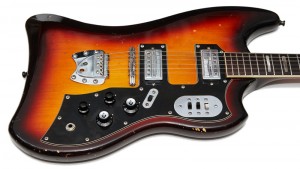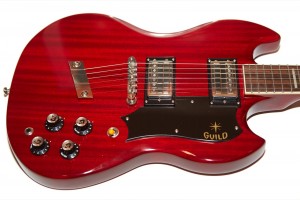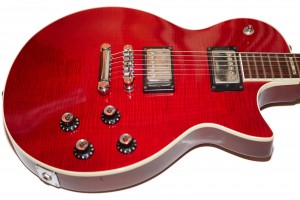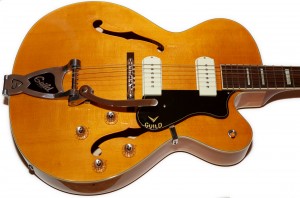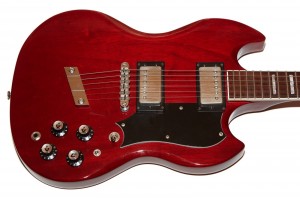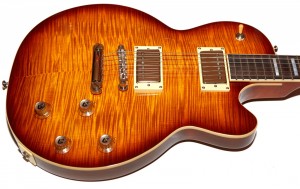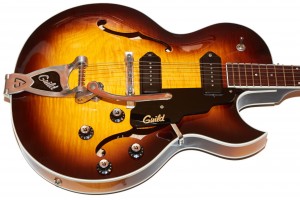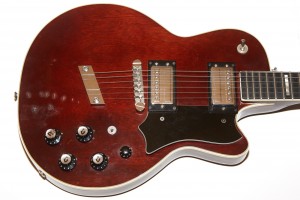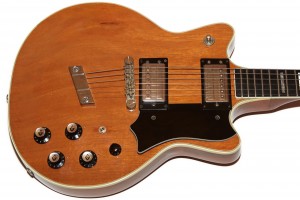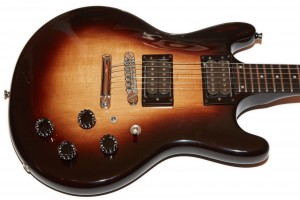I’ve never been a huge fan of the Guild S-200 Thunderbird because (hang on to your hats Guild fans), I think they’re goofy looking. They’re nicknamed “Gumby” for a reason, after all. I’m not without my fair share of curiosity, and I’m always willing to be proven wrong, so when a fellow LetsTalkGuild member asked me to work on his, I jumped at the chance. This particular specimen was certainly not mint, but it was structurally sound and played fine with one minor problem – two of the control pots were either dirty or had failed. Since I apparently have a reputation of caring about my work and not being “just some guy”, I was given the opportunity to fix a guitar that was nearly as old as me. My price? The ability to fondle the guitar and write this article based on my discoveries. Read on to discover how my opinion of this Guild classic went from goofy to fascinating.
Category: Reviews
[R] Newark St. S100 Polara (2015)
I used to have a reputation on the Lets Talk Guild forum as the guy who hated Guild S-100 guitars. I just never saw the lure, probably because I loved other models so much. When the opportunity arose to score one of the newer Newark Street models for a song, I jumped on it, figuring I could flip it and make a couple bucks profit. Sadly, I wasn’t prepared to be impressed by this guitar.
I bought this guitar used on LTG along with a Newark Street (NS) X-175B, which I will review in another post. I’ve discovered that these import Guilds absolutely crush the competition in the same price range. Let’s see why.
[R] Bluesbird (1997)
Today’s review is for a 1997 Guild Bluesbird guitar from the Westerly factory that I picked up on eBay for a great price. I didn’t need it, but it was so pretty that I couldn’t resist. Sadly, that happens to me a lot.
The Guild bluesbird of this era is quite clearly inspired by the Gibson Les Paul, but there are some important differences. First, and perhaps most important, the Bluesbird is chambered which makes it lighter than the average Les Paul while also making it more resonant with a more open sound. The shape is a bit different, and Les Paul purists will likely rebel against that, but for me, it’s every bit the guitar that even an Historic Les Paul is. Let’s find out why, and talk about some of the differences between the Guild Bluesbird and a Gibson Les Paul.
[R] Newark St. X175B (2015)
I’ve owned a few nice Gretsches including a Setzer SSLVO, a Setzer Hot Rod, and a Gretsch Billy Bo, as well as a couple of Gretsch Electromatics. I’ve also owned two Guild X170s, a pile of Guild Starfires, both of the III and IV variety, and too many other guitars to count. I have a thing for hollow-body guitars with a Bigsby, or as we in the Guild world call them when they say Guild on them, a Guildsby.
After seeing this video put out by Guild, I decided that I had to have one of these Newark Street X-175B marvels. I finally got my hands on one for a great price and was thrilled when I played it. Let’s find out why this guitar excites me.
[R] S100 Polara (1997)
Guild’s S100 guitar, which appears on the surface to be a copy of Gibson’s SG, is one of Guild’s most popular electric guitars. I’ve resisted owning one for years because they were so popular and I’m not one to spend energy trying to fit in with the crowd, but circumstances would conspire in such a way as to ensure that I suddenly had two of them – a Newark Street version, and a 1997 reissue. This article concentrates on the 1997 reissue. My article on the Newark Street S100 can help you if you’re looking for information about that model.
[R] Newark St. Bluesbird (2016)
Today’s review is of a Guild Newark Street (NS) Bluesbird from 2016. This is one of the current crop of Guild Newark Street guitars, all of which are surprisingly great instruments. After reviewing a Newark Street X-175B and then a Newark Street S100 Polara, and comparing it to a 1997 reissue S100, I had many people request that I review the NS BluesBird, so I found a new one on Reverb for a price I was willing to pay and ran it through its paces. Let’s see how it fared.
[R] Starfire III-90 (2002)
I have thing for Bigsby-equipped guitars, owing in large part to my obsession with Brian Setzer’s music. In my quest to capture Brian Setzer’s Tone, I’ve owned far too many such guitars. After buying and selling my fair share, one of my favorites is the Guild Starfire-III with P90s.
After about 2000 or so, Guild (then owned by Fender) moved production from Westerly, Rhode Island to Corona, California. A lot of people in the Guild community were worried that the legendary quality of Guild guitars would plummet with Fender at the helm, and while Fender did a great job of letting Guild electric guitars die in the long tun, having owned many of each I’m here to tell you that these Corona-made Guilds are every bit the guitar of the Westerly-made models. This guitar is no exception. Let’s find out why.
[R] Bluesbird (1974)
After recently reviewing a 1997 Guild Bluesbird and a 2016 Guild Bluesbird, I decided that I’d like to try one of the earlier 1970s models and searched around until I found this 1974 M-75 CS model on Reverb for a great price. In fact, it was a really great price likely due to the finish damage and wear obvious in the photos. Even though it’s got some warts, the guitar is structurally and electrically sound, which means that it plays and sounds great, even if it’s not up to my normal standards of near-mint guitars.
In honor of this guitars long and less-than-pristene past, I opted to photograph it right as it came from the box in all its dusty, dirty, and finish-marred glory. Let’s see how it fares given my normal desire for bright and shiny instruments.
[R] M80 CS (1975)
This odd-looking guitar came to me at the right price so I couldn’t pass up the chance to own, play, and write about the seemingly not very popular Guild M-80-CS. This example is from 1975, and is in pretty darn good condition for an almost 40-year-old guitar. Let’s take a close-up look at this 1970s Guild and see if they’re worth buying should you happen across one in your travels.
Spoiler: the answer to that last question is almost always yes when it comes to vintage Guild electric guitars.
[R] M80 (1981)
After buying, playing, and testing a 1975 M-80 CS, I decided to see about scoring an early ’80s model to see how it differed. I managed to score this tobacco burst beauty for a great price and sat down to play it, eagerly anticipating my first outing with not only a 1980’s Guild, but my first experience with Guild’s XR-7 pickups.
This guitar is unlike most of the Guilds I’ve owned in some ways while still retaining the core elements of what makes Guilds such a great guitars. But first, a bit of an introduction about Guild M-80s is in order.

